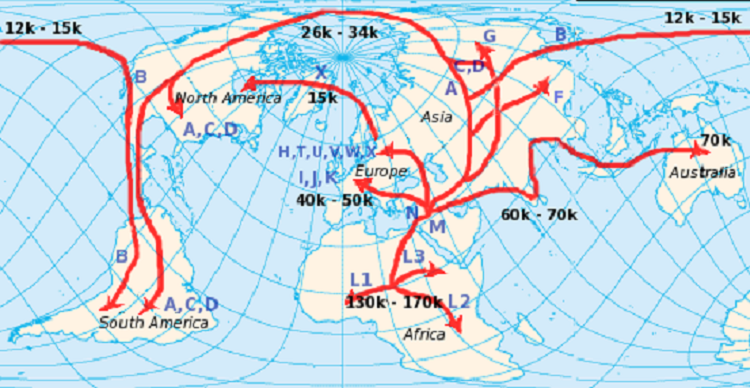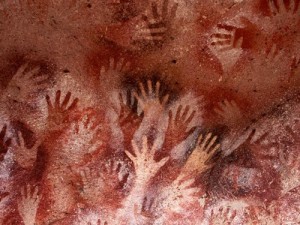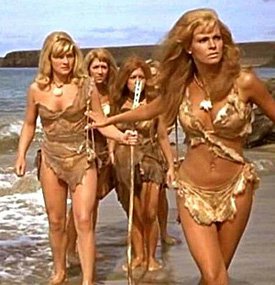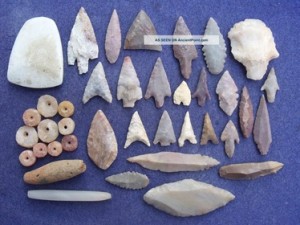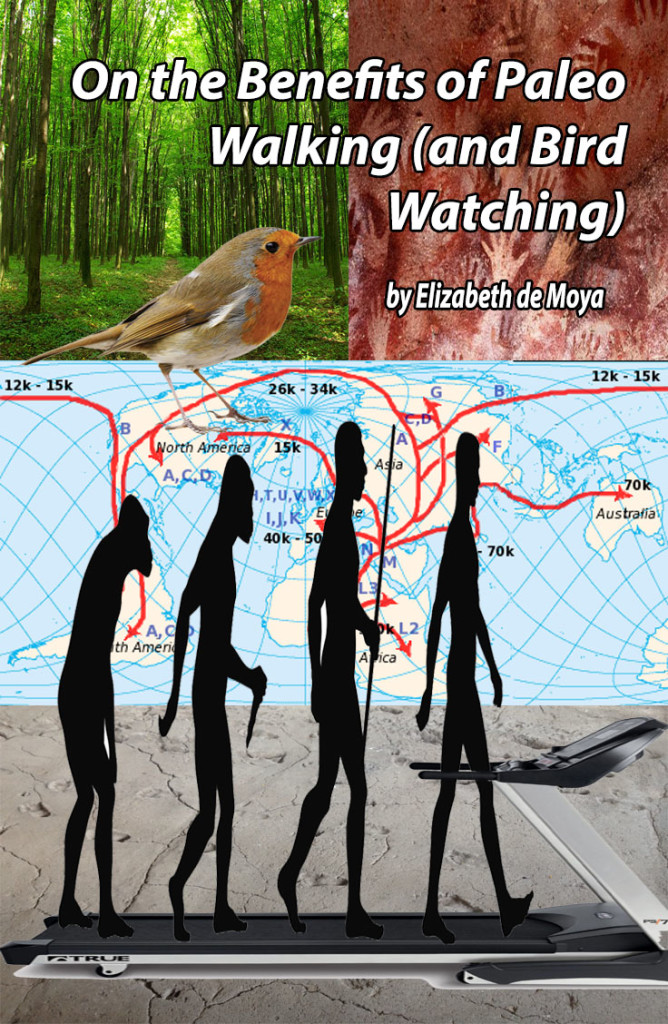Walking around a lot like your caveman ancestors did lifts the spirits and promotes good health because our bodies evolved to move great distances.
The Paleolithic era that is referred to in the paleo diet lasted from about 2.6 million years ago, when the earliest stone tools were used, to around 10,000 years ago, when we have our earliest records of agriculture in the Middle East.³
The moments between the time the species that would become man descended from the trees, discovered fire and settled down to concentrate on agriculture may be blurred, but we can be sure that they must have walked a lot. The pervading theory states that Homo sapiens spread throughout the world from Africa in the period between 60,000 and 30,000 years ago.¹ Furthermore horses were not domesticated until about 2,000 BC.²
I am not abdicating hunting for game with a pointed stick, or running for your life from a wooly rhinoceros. But it might be a good idea to get outside every once in a while, especially if you already have to walk the dog – which was domesticated 30,000 to 15,000 years ago.⁴
The Reasoning Behind Paleo-Stuff
Published in 2011, The Paleo Diet Cookbook by Loren Cordain, PhD, suggests that we can “optimize” our health by imitating the hunter-gatherer diet of our ancestors.⁵ Since then there has been a trend towards paleo living that includes fitness, sleeping, parenting and even hygiene.⁶ In 2013, Darryl Edwards published Paleo Fitness: Primal Training and Nutrition to Get Lean, Strong and Healthy.
Unfortunately on the diet you cannot enjoy any of the foods cavemen did not have, which includes beer, bread, dairy products, legumes and refined sugar. Presumably Paleolithic man subsisted on mostly protein and the fiber obtained from plant matter, which gets me thinking.
Our early predecessors were dirty and short and they lived in caves. They were lucky to make it past 30 years old, and most children died before they turned 15.⁷ These people most likely spent the majority of their time locating enough resources to stay alive – like animals do. Historians estimate that it took thousands of square miles of walking per tribe to hunt and gather up all of that food.⁸
Agriculture gained momentum sometime around 10,000 BC, which marks the end of the Paleolithic era and the start of the Mesolithic era. But people still had to walk a lot. They could not take a bus, or work remotely from home. Walking is what our bodies evolved to do. It is our main carriage of locomotion. Even if you enjoy a modern diet it is still a good idea to walk more often.
Health Benefits of Walking
Nary a fellow who has not strolled through the garden on an evening constitutional. From cave men to Victorians, walking for health is not a new idea. There are a lot of great reasons to add frequent walks to your exercise routine.
- Cute Butt – Walking is one of the best exercises you can do to tone the muscles in your gluteals plus the entire leg connected to them.
- Exercise Your Brain – The ability to walk long distances has been linked to improving memory in seniors and raising grade scores for adolescents.
- Gateway Exercise – Professionals recommend walking to people just starting out with exercise, simply because it is a free activity that anyone can do, provided they have full use of their legs.
- Lose Weight – People that walk regularly each week are more likely to lose weight without making any changes to their diet. It also reduces body fat and boosts the immune function.
- Meditation and Musings – Buddhists advocate walking meditation as a means of clearing the mind, and focusing on the present that is all around you as you take the steps.
- Reduce Anxiety and Stress – Walking creates endorphins that make you feel happy.
- Successful People Took Walks – Famous composers such as Beethoven, Mahler, Erik Satie and Tchaikovksy all made a habit of taking walks.¹¹
- You See More – When you ride in a car or on your bike, the tunnel vision effect makes it more difficult to notice the scenery. Whereas you are part of the landscape when you walk.
How to Paleo Walk (and Watch Birds)
When I say paleo walk, what I mean is walking in a more natural way like our caveman ancestors did. The best way to do this, is to literally get off the beaten path. Paved roads and concrete sidewalks are a relatively new invention, and for most people were not a part of everyday life until fairly recently. Hiking or trail running are a better workout, because navigating the obstacles on a trail requires more effort. For example you might have to scale a pile of boulders, or step around a large mud puddle. Just walking on the unevenness of the dirt path allows for a fuller expression of the muscles.
When I go for walks through parks and nature trails, I often multitask by observing the native wildlife. This is an enjoyable, albeit somewhat old fashioned, side activity that anyone can do.
It goes to reason that birds were what people must have watched before the prolific rise of theater, film and television. Many cultures, such as the ancient Romans, believed the activities of birds revealed signs of the future. It is also very relaxing, especially if you think birds are cute. The difference between a bird watcher and an ornithologist is that one does it recreationally and the other for reasons of science. The Cornell Lab of Ornithology offers a free bird identification app for your smartphone.
Depending on what country you live in right now, you probably will not be dodging any vicious marauders on your paleo walks, or hunting large game with hand to hand weapons. But you can switch it up by jumping over logs and swinging from trees or something. Many paleo fitness enthusiasts recommend using large rocks for weight lifting, and not attacking your cave enemies.
Instead of taking the same old jog through your flat, boring neighborhood, seek out local hiking trails on the Internet or in the park. Adding a regular paleo walk to your exercise routine could be one of the best things that you ever did for your health and well-being.
Sources:
- http://science.howstuffworks.com/life/evolution/human-migration3.htm
- http://www.ancient.eu/timeline/Agriculture/
- http://dictionary.reference.com/browse/paleolithic
- http://news.sciencemag.org/archaeology/2015/04/feature-solving-mystery-dog-domestication
- http://thepaleodiet.com/the-paleo-diet-premise/#.VlsXSL9U7Yg
- http://www.newyorker.com/magazine/2014/07/28/stone-soup
- http://www.scientificamerican.com/article/why-paleo-diet-half-baked-how-hunter-gatherer-really-eat/
- http://www.timemaps.com/farming
- http://www.marksdailyapple.com/17-reasons-to-walk-more-this-year/#axzz3suglzHH9
- http://www.runnersworld.com/getting-started/8-reasons-to-walk
Elizabeth de Moya lives near San Diego, CA. She volunteers for the birds, and she works at the zoo. She is going back to school to study pre veterinary medicine. She has a BA in Linguistics from UC Berkeley.
